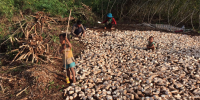
https://unsplash.com/photos/fD9oHpvG7NE
Reacting to reform: Cambodia’s environment
Cambodia’s new environmental policies are promising, but they also signal a government agenda to consolidate power over the country’s forests, Sarah Milne writes.
In 2016, Cambodia’s Prime Minister Hun Sen announced a dramatic suite of jurisdictional and policy reforms that will affect how land and forests are governed in Cambodia for decades to come.
Implementation of the reforms is still partial, but we must be aware of their potential effects for people and nature. Close attention must especially be paid to the rights of indigenous people and peasant farmers as the reforms proceed. A key winner from the recent reforms is the newly empowered Ministry of the Environment, now controlled by a young Australian-educated Excellency, Mr Say Samal.
Mr Samal is a representative of the ruling Cambodian People’s Party, hand-picked by the Prime Minister to lead Cambodia’s new environmental portfolio, which includes the drafting of an ‘environmental code’ to harmonise legislation, alongside expansive new protections for ecosystems and biodiversity.
The most conspicuous aspect of the reforms is jurisdictional. Vast swathes of Forest Estate, which were originally controlled by the Forestry Administration, have been converted into ‘protected areas’ and ‘biodiversity conservation corridors’ to be managed by the Ministry of the Environment, in addition to an already substantial set of conservation areas. As a result, Cambodia’s protected area system now covers a remarkable 39 per cent of the country’s surface area or 7.4 million hectares.
The only country in the world that has a greater proportion of its territory protected for the purposes of nature conservation is Bhutan. So, does this mean that Prime Minister Hun Sen has become an environmental leader? Can Cambodia now reclaim its title of being the forested jewel in the crown of mainland Southeast Asia?
Given the recent history of protected areas in Cambodia, it is wise to be wary of such environmental success claims.
Scholars have long shown that a key aspect of protected area management in Cambodia is the assertion of state control over territory and resources.
Map-making, boundary demarcation, zoning, and the promulgation of rules are all aspects of what is often termed ‘state territorialisation’. The results of this process typically include enhanced government power and a state monopoly over resources.
In the Cambodian case, this increased governmental activity in the name of nature protection has been highly problematic for two key reasons.
First, protected areas have generally inhibited formal recognition of local people’s land and resource rights. Tens of thousands of rural and indigenous people who now live within Cambodia’s protected areas are therefore living in a state of uncertainty.
By law, so-called ‘sustainable use zones’ and ‘community zones’ should be allocated to local residents, but livelihood safeguards in these yet-to-mapped zones are likely to be limited, while prospects for formal property rights remain distant.
Second, with the alienation of local communities within protected areas, the government has been able to assert control over forested land for its own benefit. For example, the government’s modus operandi in protected areas to date has seen the establishment of illegal logging rackets by tycoons and elites, with the tacit blessing of the ruling party.
Much of this illicit logging activity has occurred alongside formal investments including the construction of hydropower dams in forested areas, and the establishment of industrial plantations through economic land concessions, which either overlap or border with protected areas. In 2012, 70 per cent of new land concessions overlapped with conservation areas.
Over the last decade, the impact of this activity upon forests has been devastating: Cambodia was the country with the third-highest national deforestation rate in the world over the period 2000-2012. This is remarkable when we consider that the country has no official logging industry and a formal logging ban.
Furthermore, the proceeds from Cambodia’s illicit logging have served Hun Sen’s regime nicely, with profits going into the hands of elites and party coffers.
Cambodia’s protected areas must, therefore, be considered partly as a form of regime-bolstering, territorial control over resources. New protected areas, while promising for the environment, must, therefore, be scrutinised carefully as they play out in practice.
As development partners now engage with Hun Sen’s green interventions, they must look to the recent past. Cambodia’s track-record in environmental management over the last decade is exemplary of state predation and the authoritarian perversion of green ideals. This should serve as a cautionary tale for sustainability policy in the region.
Going forward, Cambodia must be supported in its environmental ambitions, but development partners should also push for the rights of local and indigenous people to be recognised in the process. Otherwise, Cambodia’s green ideals will ring hollow.
Updated: 1 September 2024/Responsible Officer: Crawford Engagement/Page Contact: CAP Web Team












